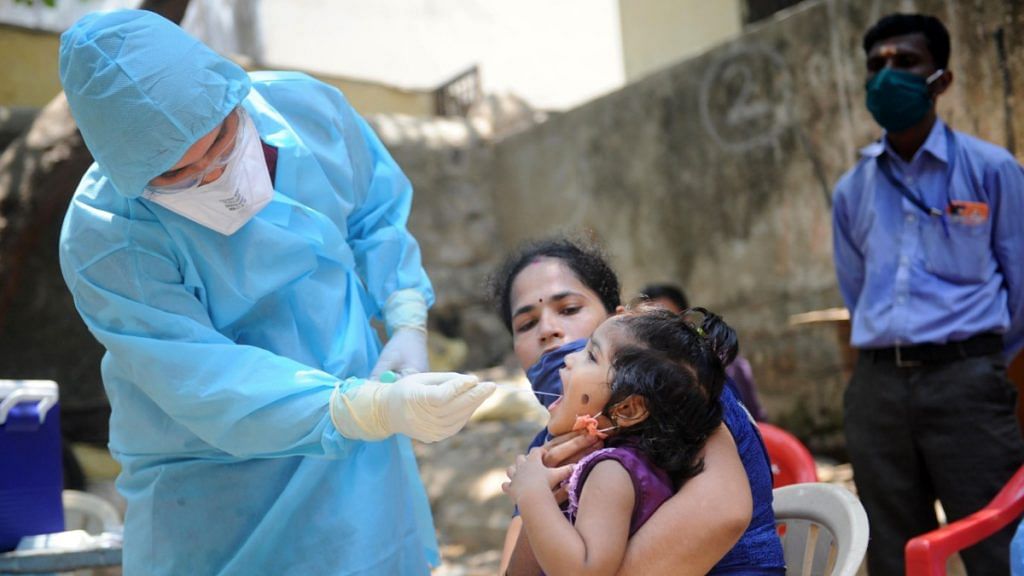New Delhi: One in every 24 Indians tested are infected with Covid-19, said the Indian Council of Medical Research (ICMR), the country’s apex medical research body that has been leading India’s testing exercise since the virus first surfaced here.
Speaking at a press briefing, Raman R. Gangakhedkar, head of Epidemiology and Communicable diseases, ICMR, cited government data to address concerns of how much India is testing, but did not comment on whether these numbers indicate the prevalence of the disease in the country.
“Japan does 11.7 tests to get one positive … It is one of the highest numbers of tests being done to find positive cases. Italy does 6.7 tests whereas the US and UK does 5.3 and 3.4 tests, respectively, to detect one positive case,” said Gangakhedkar.
According to ICMR’s latest bulletin, on 15 April, a total of 2.74 lakh samples have been tested in India.
As of this week, Japan has tested 89,551 in total (14 April), the US 3,081,620 (14 April), the UK 313,769 (15 April) and Italy 1,117,404 (15 April), according to the statistics and data analysis website Our World in Data.
Vietnam has tested the maximum — 496 — to find one positive patient, followed by Taiwan (71.9) and Russia (62).
India’s relatively low rate of testing has sparked speculation, and criticism, that its official tally doesn’t entirely represent the true size of the outbreak in the country.
“India does 24 tests and finds one positive which means the rest 23 were Covid-19-negative patients. Looking at absolute numbers of tests is not a right measure,” said Gangakhedkar.
Although the epidemiologist did not explain if this means that the incidence of disease is low in the country, he did say that the “strategy adopted by India is working”.
“It means we initiated actions in advance and have well-defined protocols for testing. So even if we test 24 people, 23 are negative.”
Also read: One coronavirus patient infects 1.7 people in India, much lower than in China, Italy: Study
Testing in Green Zones
Lav Aggarwal, Joint Secretary at Union Ministry of Health and Family Welfare, who was also present at the briefing, said the government is testing even in the districts where there are “no Covid-19 cases” at all. According to the government’s latest categorisation, such districts are called Green Zones. Districts with the highest prevalence, or hotspots, are called Red Zones, while those with lesser case numbers are designated White Zones.
There are currently 170 districts in the Red Zone, 207 districts (non-hotspots) in the White Zone and 353 districts (zero cases) in the Green Zone.
“We are checking people under our testing protocols who have severe acute respiratory illness (SARI) or Influenza-like illness (ILI). The testing is ongoing even in the districts where there is no case of Covid-19 presently,” Gangakhedkar said.
The government also shared the list of 27 districts in 17 states where zero samples tested positive in the last 14 days.
The list includes Patna (Bihar), Nadia (West Bengal), Pauri Garhwal (Uttarakhand), Porbandar and Somnath (Gujarat), Pratapgarh (Rajasthan), Pilibhit (Uttar Pradesh) and West Imphal (Manipur) among other districts.
“There are around 325 districts in the country with no Covid-19 cases,” Aggarwal said.
Also read: A war room, drones, CCTVs — how ‘hotspot’ Agra became Covid-19 model town
Chinese test kits to map and not diagnose
The Centre also announced that it received the much-awaited rapid testing kits from China.
“We have received five lakh kits for rapid testing from Livzon Diagnostics and WondFo diagnostics in China,” Gangakhedkar said at the press briefing.
He further explained that the rapid antibody testing is conducted for “surveillance purposes” and to track the progression or regression of the disease in a particular geographical area. “The antibody comes in the body after several days of pathogen invasion. It will be too late for diagnosis, if we relied on this testing,” the ICMR scientist said.
A rapid antibody test shows if a person once infected by the coronavirus has developed the immunity to it.
The kits were delayed due to reports of inaccuracies in their results. However, ICMR said “the kits will be used for mapping a trend, and not diagnosis. Even if the kit has an error rate, which is uniform across all results, we will be able to map the trend and use it for surveillance”.
The human body develops two kinds of antibodies — immunoglobulin M (IgM) and immunoglobulin G (IgG). These antibodies remain in the body from between a month to a year, or even longer in some cases.
Also read: Yes, young people are falling seriously ill from Covid-19
